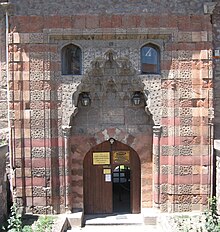Mu'in al-Din Parwana
| Muʿīn al-Dīn Sulaymān Parwāna | |
|---|---|
| |
| Died | August 2, 1277[1] |
| Religion | Islam |
Muʿīn al-Dīn Sulaymān Parwāna (
.
Biography
Mu'in al-Din Suleiman was the son of Muhadhdhab al-Din Ali al-Daylami, a
After Kaykhusraw’s death and the ensuing dispute among his sons for the throne, the Parwana supported
During the Mamluk-Ilkhanid War and especially after the Mamluk hand had strengthened under Baybars, Parwana's policy was characterized by multiple allegiances, all at the same time wishing to keep all his options open. According to
In 1277, Baybars entered the Seljuk sultanate and on 18 March, overcame the Mongol army in Elbistan, while Parwana, who was in command of the Seljuk contingent expected by both Baybars and the Mongols, took flight to Tokat along with the young sultan. Baybars made a triumphal entry into Kayseri on 23 April and then returned to Syria. At the news of his troops' defeat, Abaqa hastened to Anatolia (July 1277) and sternly punished the Seljuk Turks, sources citing massacres of tens of thousands of people. Deeming him responsible for Baybars's foray into Anatolia, Abaqa also had Parwana killed on 2 August 1277.
The story that the Abaqa forced his subjects to eat the flesh of the Parwana has its origin in Armenian history of Hetoum.[5]
His son Mehmed Bey took over the family possessions around Sinop and pursued a prudent policy of allegiance to the Mongols, which was also pursued under his son Mesud Bey's period as Bey. Mesud Bey was kidnapped by the Genoese in 1298 and was held for a heavy ransom. The last representative of the Parwana's line was probably the Gazi Chelebi, a notable pirate who ruled Sinop in the first decades of the 14th century.[citation needed]
Monuments
Several foundations of the Parwana survive. In Sinop the
Recently the archaeological remains of a medrese founded by the Parwana came to light within the compound of the closed bazaar of Kayseri. The medrese was partially excavated in 2002.[8]
See also
References
- ^ Hillenbrand 1993.
- ISBN 90-04-09738-4.
Muin* al-Din Sulayman Parwana: de facto ruler of the Saljuq state of Rum in Anatolia during most of the Mongol Protectorate; d. 1277. Of Persian stock, he attempted to maintain stability both amongst the Turkish emirs and between them and the ever-increasing number of Mongols resident on Anatolian soil. He is said to have enjoyed a close relationship with Jalal al-Din Rumi.
- ^ E. J. Brill's First Encyclopedia of Islam, p. 704 Google Books
- ^ Bosworth 1996, p. 230.
- ISBN 0-415-29750-8.
- ^ Anthony Bryer and David Winfield, The Byzantine Monuments and Topography of the Pontos, vol. 1, (Washington D.C.: Dumbarton Oaks, 1985) 75.
- ^ Bryer and Winfield, Byzantine Monuments, p. 72
- ^ Seda Çalışır Hovardaoğlu. "Pervâne Bey Medresesi olarak adlandırılan yapının ve Kayseri Kapalıçarşısı'nın korunması yönünde alınan kararlar ve değerlendirilmesi" [The decisions taken for the protection of Kayseri closed bazaar and Pervâne Bey Medrese] (PDF). Erciyes University (in Turkish).
Bibliography
- (limited preview) ISBN 0-521-46226-6.
- Bosworth, Clifford Edmund (1996). New Islamic Dynasties: A Chronological and Genealogical Manual. Edinburgh University Press.
- (limited preview) ISBN 0-8135-1304-9.
- Hillenbrand, Carole (1993). "Muʿīn al-Dīn Sulaymān Parwāna". In ISBN 978-90-04-09419-2.
